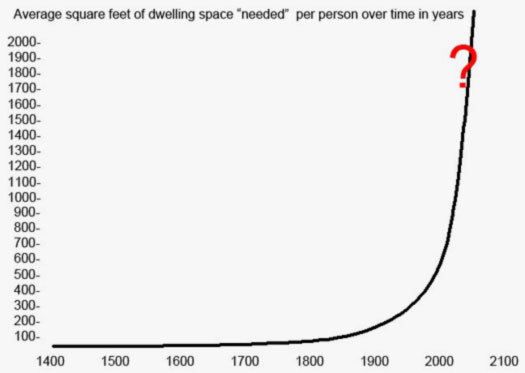
Tom Friedman's book The World Is Flat 3.0: A Brief History of the Twenty-first Century (2005) is filled with anecdotes about change in different parts of the world that threaten our fat-cat lifestyles in the North. “One cannot stress enough: Young Chinese, Indians and Poles are not racing us to the bottom, they are racing us to the top” wrote Friedman at the time; he added that “in China, when you are one in a million, there are 1,300 other people just like you.”
I've been preoccupied, since reading Friedman's book, by what “flat” and “equal” might mean in terms of urban living space. When I started collecting data on the average space per person, I came up with these startling numbers for square metres per person (add a zero to turn them into square feet):
USA 60
Britain 38
Germany 38
France 37
Japan 31
China 25
Russia 5.0
Laos 6.5
Egypt 6.2 (Manshiet Nasser)
Nigeria 1 (Kiberia)
The trend in rich countries, until the crisis, was for bigger homes with fewer occupants: between 1950 and 2000, in the US, living space per person increased by 183% and home size increased by 120%.

For decades, shrinking household size, growing incomes and local zoning regulations fuelled demand for more and larger homes on larger lots. Land prices increased in large part due to the total overall demand for residential property.
What will the consequences be if that trend is reversed and space per person starts to converge on a global average?
During the Great Depression, after all, the number of people living in a US home often doubled. By all accounts, that pattern is repeating itself today. The reason more people are not living in tent cities or on the streets is that large numbers of children are moving back in with their parents, or vice versa. Until the crisis, the US had a density of about 2.4 or so people per housing unit. If this were to increase 30 per cent it would mean about 30 million excess housing units.
In the UK, too, there seems to be a remarkable growth of space that people don’t need. George Monbiot discovered the remarkable fact that between 2003 and 2008 (the latest available figures), there was a 45 per cent increase in the number of under-occupied homes.
Meanwhile, by the end of last year, the floor space per household in China averaged 20.4 square meters, just at the level of medium-income countries. If global trends converge demand for more housing will continue to drive growth — but only until average floor space reaches 30 to 35 square meters/per capita.
Yes, I'm playing fast-and-loose with numbers here. Multiple factors are at play in different parts of the world. But if the trend towards a levelling of space per person is even is broadly true, prospects for the mighty Real Estate Industrial Complex look less rosy than they've been for generations.


Comments [3]
A reversal in the trend of diminishing people per dwelling is another reason why there is less likely to be a manufacturing-led recovery (in developed nations).
But this also represents an opportunity for designers. Design since WWII has been all about design for single owner-operators. We have almost nothing that has been carefully or innovatively designed for joint ownership / shared use. But now there is a clear market for multi-user products.
There is also some social innovation needed. Settersten and Ray point out in their new book ( http://www.notquiteadults.com/ - about the increasing number of college grads returning home) that whilst there are lots of books about parenting youngsters, there are very few guides to parenting 30yr olds still living at home (#1stworldproblem).
Cameron
01.24.11
02:46
There's a presentation on this by Francois Jegou, a service designer, here: http://issuu.com/sustainable-everyday/docs/ctc_paper_en
01.25.11
02:59
01.25.11
08:13